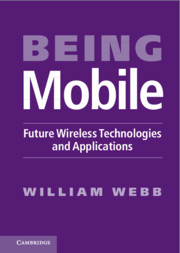Book contents
- Frontmatter
- Contents
- About the author
- List of abbreviations
- 1 Introduction
- Part I Technologies
- 2 4G cellular
- 3 Femtocells
- 4 Cells in the sky
- 5 Mesh networks
- 6 Software-defined radios and new receiver architectures
- 7 Cognitive or white-space systems
- 8 Codecs and compression
- 9 Devices
- 10 Network architectures
- 11 The green agenda
- Part II Solutions
- 12 The future of users
- 13 Sensors
- 14 Social communications
- 15 Location
- 16 Healthcare
- 17 Transport
- 18 Entertainment
- 19 The smart grid
- 20 Assisted living
- 21 Universal service
- 22 Summary
- Index
- References
8 - Codecs and compression
from Part I - Technologies
Published online by Cambridge University Press: 05 October 2013
- Frontmatter
- Contents
- About the author
- List of abbreviations
- 1 Introduction
- Part I Technologies
- 2 4G cellular
- 3 Femtocells
- 4 Cells in the sky
- 5 Mesh networks
- 6 Software-defined radios and new receiver architectures
- 7 Cognitive or white-space systems
- 8 Codecs and compression
- 9 Devices
- 10 Network architectures
- 11 The green agenda
- Part II Solutions
- 12 The future of users
- 13 Sensors
- 14 Social communications
- 15 Location
- 16 Healthcare
- 17 Transport
- 18 Entertainment
- 19 The smart grid
- 20 Assisted living
- 21 Universal service
- 22 Summary
- Index
- References
Summary
Basics of compression
Capacity on wireless channels is often scarce. As discussed in earlier chapters, the capacity of a wireless system is determined by the efficiency of the technology, the amount of spectrum and the number of cells. Adding additional capacity almost invariably comes at a cost and hence there is an incentive to reduce the capacity requirements as much as possible. Only in certain networks, such as within the home, where the wireless systems provide more than sufficient capacity, is this not true – but even in these cases the demands have a tendency to grow to take up the available capacity.
One approach to reducing capacity needs is compression. Many of the types of information to be transmitted have significant redundancy within them – for example, much of speech is silence (between words or when the other party is talking), while one video frame tends to be very similar to the preceding one. In some cases huge reductions in data rates can be achieved by compressing the data stream. For example, one of the major gains in the number of voice calls that could be handled on moving to 2G cellular was the ability to use digital encoders to digitise voice and in the process substantially reduce the data rate needed. In this chapter we cover the current capabilities and likely future progress of encoders and decoders (collectively known as ‘codecs’) and consider the implications for wireless data requirements in the future.
Information
- Type
- Chapter
- Information
- Being MobileFuture Wireless Technologies and Applications, pp. 73 - 79Publisher: Cambridge University PressPrint publication year: 2010
